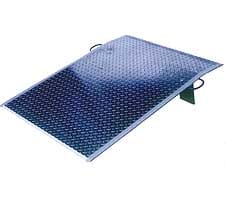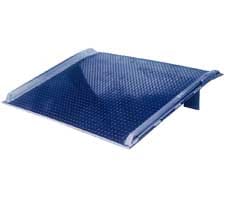How to Guide to Dock Boards & Dock Plates
Dock Boards and Dock Plates are a portable, non-permanent solution to loading semi truck trailers at a loading dock. These dock ramps bridge a gap from the dock to the truck, overcoming both the gap distance as well as the height differential between the truck and the dock. Typically, dock boards are of heavier-duty construction than dock plates and allow for utilizing a forklift to load and unload a trailer.

Aluminum Dock Plate
(Note the lack of guide rails)
Dock Plates
The surface of a dock plate is typically safe and skid-resistant. A ten degree bend in the plate allows edges to be flush at both the dock and truck for smooth material transfer. Beveled edges reduce wear and excessive equipment jarring. Locking legs secure the plate for safe loading and unloading. This unit also comes complete with carrying handles attached to the locking legs for easier portability.
Also notice that the dock plate does not have guide rails on the sides. This is typical of dock plates as they are not usually handling vehicular traffic such as forklifts. Also notice that to prevent run-off, the edges of the dockplate are distinguished by different shades as well as the lack of diamond plating.
Dock plate capacities range from 1,800 lbs. to 5,500 lbs.
View the new dock plates in our online store.

Aluminum Dock Board
(Note the Guide Rails)
Dock Boards
What are dockboards? Dockboards are engineered and built to safely handle heavy forklifts and loads. Capacities from 5,000 lbs. to 30,000 lbs. are available. Locking legs prevent movement during loading and unloading. Locking legs are uneven to allow the dockboard to sit canted for easier pickup by forklifts, when picking off the floor. Dockboards also feature side curbs to prevent vehicles (forklifts) and loads from falling between the truck and the dock - this is known as run-off and is a serious safety concern.
View the new dock boards in our online store.
Selecting a Dock Board
Step 1: Determine Capacity
Dock board capacities are based upon the heaviest type of equipment used plus the maximum load carried times the percentage of single axle rating of total load carried - as shown in the formula below.
Dock Board Capacity Formula:
(Equipment Weight + Max Load Weight) x Single Axle Rating of Total Load = Dock Board Capacity NeededTable to Determine Single Axle Rating of Various Modes of Transportation:
| Equipment |
Single Axle Rating |
| Two-wheel hand trucks |
100% |
| Four-wheel platform truck (non-tilt) |
50% |
| Pallet trucks-hand |
75% |
| Pallet trucks-electric |
66% |
| Platform (skid) trucks-hand-walkie |
75% |
| Platform (skid) trucks-electric-walkie |
66% |
| Fork trucks-electric walkies |
90% |
| Fork trucks-electric rider |
90% |
| Fork trucks-gas rider |
90% |
Step 2: Determine Overall Width Needed
The width of your dockplate or dockboard should be at least 15" wider than the load or equipment passing between the curbs. If the load does not pass between curbs but is elevated above, add 15" to overall width of the equipment.
Step 3: Determine Maximum Height Differential
Use this guide for truck floor heights to determine the height differential from the truck bed to dock.
Note: Numbers reference an empty truck
| Truck Type |
Typical Height Range |
| Refrigerated |
54 to 61 inches |
| Heavy trailers |
51 to 56 inches |
| Heavy semi-trailers |
48 to 54 inches |
| Light semi-trailers |
45 to 49 inches |
| Large single bed |
42 to 50 inches |
| Small single bed |
30 inches |
Step 4: Determine Plate Length
Use the information below to determine the length of the plate needed.
| Height Differential |
Dock Board Size |
| 10 inches |
54" width x 60" length |
| 10 inches |
54" width x 72" length |
| 4 inches |
60" width x 30" length |
| 5 inches |
60" width x 36" length |
| 7 inches |
60" width x 48" length |
| 10 inches |
60" width x 60" length |
| 12 inches |
60" width x 72" length |
| 4 inches |
72" width x 30" length |
| 5 inches |
72" width x 36" length |
| 10 inches |
72" width x 60" length |



